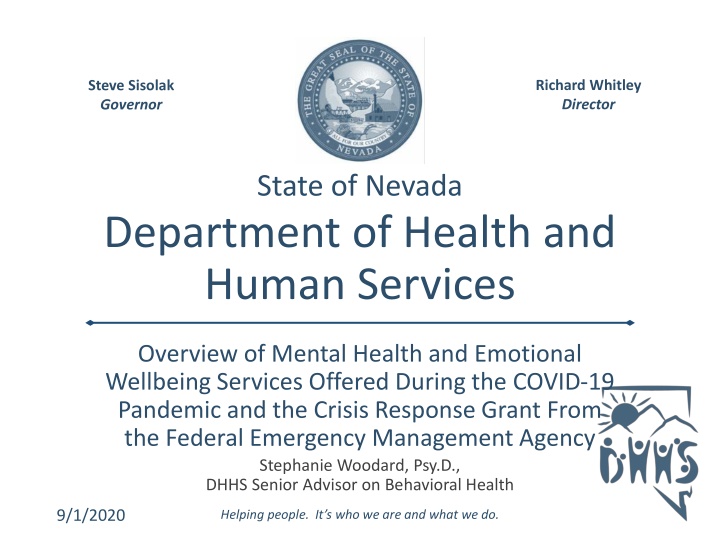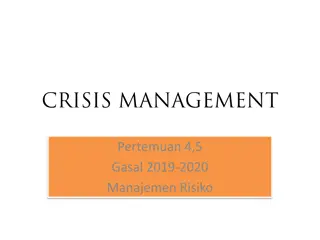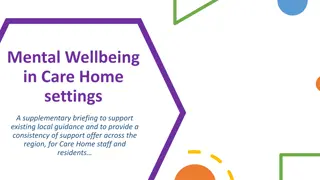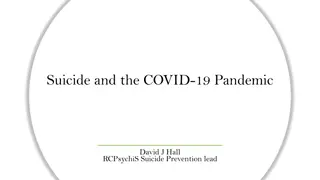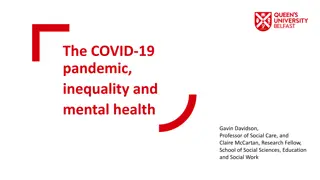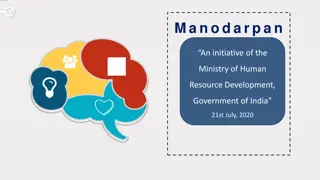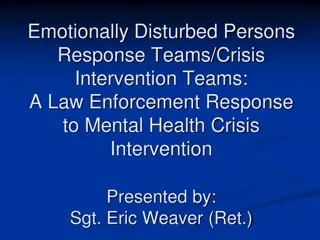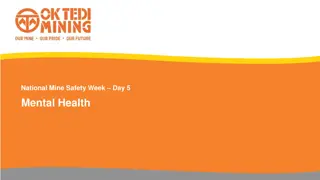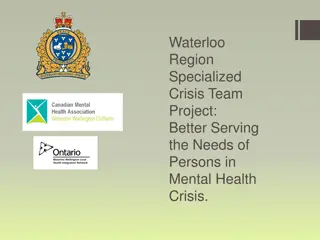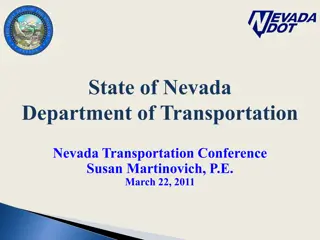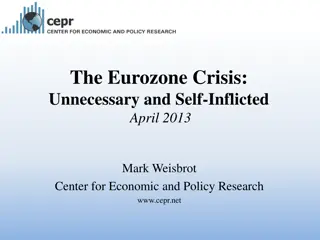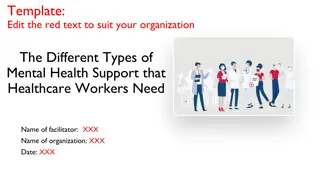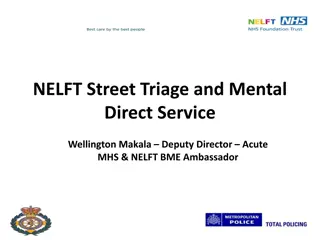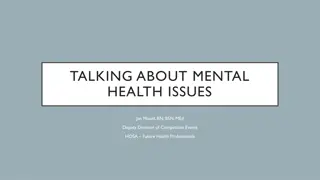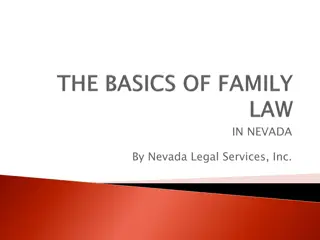Mental Health Services and Crisis Response in Nevada During COVID-19 Pandemic
In Nevada, the Department of Health and Human Services, under the leadership of Director Richard Whitley, is actively providing mental health and emotional well-being services during the COVID-19 pandemic. They have established a comprehensive plan to address behavioral health needs in emergencies and disasters, emphasizing continuity of services, triage, psychological first aid, and support for first responders. The key concepts of disaster response highlight the importance of community resilience and mutual aid in times of crisis.
Download Presentation

Please find below an Image/Link to download the presentation.
The content on the website is provided AS IS for your information and personal use only. It may not be sold, licensed, or shared on other websites without obtaining consent from the author.If you encounter any issues during the download, it is possible that the publisher has removed the file from their server.
You are allowed to download the files provided on this website for personal or commercial use, subject to the condition that they are used lawfully. All files are the property of their respective owners.
The content on the website is provided AS IS for your information and personal use only. It may not be sold, licensed, or shared on other websites without obtaining consent from the author.
E N D
Presentation Transcript
Richard Whitley Director Steve Sisolak Governor State of Nevada Department of Health and Human Services Overview of Mental Health and Emotional Wellbeing Services Offered During the COVID-19 Pandemic and the Crisis Response Grant From the Federal Emergency Management Agency Stephanie Woodard, Psy.D., DHHS Senior Advisor on Behavioral Health 9/1/2020 Helping people. It s who we are and what we do.
Phases of Disaster Response and Operations 2 SAMHSA_FEMA Crisis Counseling and Training Program; https://www.samhsa.gov/dtac/ccp-toolkit
Assembly Bill 206, enacted 2019 The Department shall develop a written plan to address behavioral health needs in an emergency or disaster. Prescribe a process for assessing the need for behavioral health resources during or after an emergency or disaster based on the estimated impact of the emergency or disaster and the estimated depletion of resources during the emergency or disaster; Ensure continuity of services for existing patients with a mental illness, developmental disability or intellectual disability during an emergency or disaster; Prescribe strategies to deploy triage and psychological first aid services during an emergency or disaster; Identify opportunities for the rendering of mutual aid during an emergency or disaster; Prescribe procedures to address the behavioral health needs of first responders during and after an emergency or disaster; and Prescribe measures to aid the recovery of the behavioral health system after an emergency or disaster. On or before December 31 of each year, the Department shall: Review the plan developed pursuant to subsection 1 and revise the plan as necessary; and Transmit the plan to the Chief of the Division of Emergency Management of the Department of Public Safety 3
Disaster Response and Operations Every disaster is different Trauma affects individuals and the community Response strategy depends on disaster characteristics A disaster causes disruptions and changes 4 SAMHSA_FEMA Crisis Counseling and Training Program; https://www.samhsa.gov/dtac/ccp-toolkit
Key Concepts of Disasters A disaster is a sudden event that has the potential to terrify, horrify, or engender substantial losses for many people simultaneously. Fran Norris, Ph.D., NCPTSD No one who sees a disaster is untouched by it Affects individuals and communities People pull together during and after Stress and grief are normal reactions People s natural resilience will support individual and collective recovery Pandemics, such as COVID-19, are considered disasters 5 SAMHSA_FEMA Crisis Counseling and Training Program; https://www.samhsa.gov/dtac/ccp-toolkit
Early ESF 8-1 COVID-19 Activities Established the COVID-19 BH Advisory Group. Collaborated with Governor s office to create the NV Health Response website Worked with SERV-NV Battle Born Medical Corp to expand the State s health care capability Manage the two SERV-NV BH organizations: Mental Health Crisis Counselor (N=44) and Psychological First Aid (N=58) Recruited/trained 500 individuals in Psychological First Aid Support a 3-tiered support system for health care providers 7
Outreach for Crisis Support Services of Nevada 8
State Emergency Registry of Volunteers (SERV-NV) Mental Health Crisis Counselors (MHCC) Volunteers: Licensed or certified mental health professionals Formally trained in crisis mental health counseling and in psychological/mental health first aid/or an equivalent Psychological First Aid (PFA) Volunteers: Non-traditional, natural community-based helpers, healers, and peer supporters Formally trained in psychological/mental health first aid or an equivalent 9
Psychological First Aid (PFA) Safety Calmness Connectedness Self and Community Efficacy Hope 10
8 Core Actions of PFA Contact and Engagement Safety and Comfort Stabilization Information Gathering Practical Assistance Connection with Social Supports Information on Coping Linkage with Collaborative Services 11
Behavioral Health Resource Request Process All behavioral health resource requests begin at the local level where the requestor initiates the process by sending the request to the Emergency Operations Center using the NDEM/SEOC Resource Request Form. The requests only proceed up to the next governmental EOC level if the request can not be filled at the lower level. 12
ESF 8-1 COVID-19 Activities Maintain a one-stop resource list of crisis support services for health care workers/first responders. Work with Regional BH Coordinators to provide consistent messaging and to promote access to services. Ensure continuity of BH services. Work to reduce pressure on EDs. Worked with ADSD to establish the Nevada CAN project. 13
Behavioral Health COVID-19 Response and Recovery Activities Collaboration with Divisions of Emergency Management Support providers in stabilizing services Promote telehealth Develop workforce Implement behavioral health prevention and early intervention Ensure access to services throughout the continuum Plan for Nevada COVID-19 Behavioral Health Recovery Evaluate data to determine unmet or anticipated need Leverage existing funding; provide flexibilities Apply for additional federal funding Liaison with providers and federal partners Launch the Crisis Counseling Assistance and Training Program 14
Nevadas Substance Abuse Prevention and Treatment, Block Grant (SABG) The Bureau of Behavioral Health Wellness and Prevention Team (BBHWP) worked to engage SABG Prevention Coalitions as of March 27, 2020 to discuss the needs of primary needs and needs of the community as well as key concerns. During the initial call, Coalition Directors were given the opportunity to discuss Key Concerns: Communication Financial stability of community programs Connectivity Equipment Long term solutions BBHWP Responses: Established Weekly Meetings to ensure connectivity between all partners and to disseminate real time information as well as COVID-19 updates from Governor and SAMHSA Project officers worked within the federal and state guidelines to provide as much flexibility of funding due to the COVID-19 restrictions. Delivered immediate feedback and support to Coalitions to achieve equipment/ tools and resources to stay connected with our Youth. Guidance on creative initiatives, best practices for short and long term solutions. 15
Nevada Opioid Treatment Providers (OTP s): COVID-19 Preparedness & Ongoing Supports The Nevada Department of Health and Human Services, Division of Public and Behavioral Health (DPBH) provided direct supports with the assistance of Bureau of Health Care Quality and Compliance (HCQC). Opioid Treatment Provider s (OTP s) under the guidance provided by SAMHSA, State and program efforts focused on continuing services to vulnerable populations by developing quickly how to meet those needs. All OTP s immediately adopted emergency management plans submitted to the State Opioid Treatment Authority. OTP s had the option to submit a blanket exception requested through SAMHSA concerning policies or procedure changing during COVID-19, which was supported by DPBH and HCQC to continue to support ongoing services during the pandemic. Per the Federal COVID-19 guidance the following was allowed to assist outreach and the continuation of treatment for Opioid use disorder (OUD). Blanket take home medication for high risk populations: Medical provider could determine a safe number of take-home doses, taking into consideration the patient s stability in treatment and ability to safely store and protect medication, not to exceed 14 days of medication. Provider took immediate steps to identify patients with significant medical comorbidities and provided other locations away from the general public for ongoing evaluation and medication dispensing. For selected patients with only one take home schedule could be staggered, reducing traffic and supporting social distancing guidelines Patients in any population deemed unsafe for take homes continued to be provided daily dosing in the clinic with all mandatory precautions for social distancing and for the patient's safety. 16
State Opioid Response (SOR) Grant - COVID The SOR team: 1. Developed outlines for emergency preparedness specific to medication assisted treatment (MAT) and treating patients with an opioid use disorder in Nevada. 2. Established guidelines and provided Emergency Preparedness memo for all Nevada OTP facilities. 3. Expanded telehealth services for opioid related treatments. 4. Provided take home MAT 5. Med delivery (as requested by patient) 17
Medicaid Telehealth Guidance Expanded Service Eligibility March 17, 2020 Federal regulations lifted restrictions on telehealth services. Previously only crisis intervention and targeted case management were allowed telephonically. March 19, 2020 DPBH lifted restrictions allowing group therapy to be delivered via telehealth. March 30, 2020 The Office of Civil Rights at the Federal Department of Health and Human Services released guidance relaxing HIPAA enforcement of technology platforms utilizing telehealth. This allowed health care providers to utilize popular platforms for video hosting to include Apple FaceTime, Facebook Messenger, Google Hangouts video, Zoom, and Skype, to provide telehealth without risk of penalties for noncompliance with the HIPAA Rules related to the good faith provision of telehealth during the COVID-19. April 13,2020 DPBH announced Psychosocial Rehabilitation (PSR) services would be permitted through traditional telehealth audiovisual communication for individuals under the age of 18 throughout the period of the COVID-19 pandemic, as a disruption in services is not in the best interest of the youth served by Medicaid. DPBH adjusted grant funding for non-profits to ensure purchase and engagement of telehealth equipment across Nevada. 18
Medicaid Behavioral Health (BH) Telehealth Utilization From April 1, 2020 to April 30, 2020 From May 1, 2020 to May 31, 2020 Since March 2020, the number of patients using BH telehealth services increased by 100% and spending by 172%. In-person patients decreased by 22% with an 8% decrease in spending. A decrease in BH telehealth patients by 3% and payments by 7%. An increase in BH in-person patients by 1% and decrease in payments by 3%. BH telehealth services accounted for 21% of all BH patients and 3% of all payments made for BH services this month. Telehealth patients accounted for 21% of all BH patient services and 3% of total paid for these BH patients this month. From March 1, 2020 to March 31, 2020 There were 7,302 BH patients using telehealth services and 68,794 BH patients using in- person services. In March, Medicaid paid $1,372,419 for BH telehealth services and $121,354,816 for BH in-person services. From June 1, 2020 to June 30, 2020 A decrease in telehealth patients by 17% and in spending by 17%. A decrease in in-person patients by 2% and payments by 14%. BH telehealth patients accounted for 18% of all BH patients and payments were 3% of all BH service payments. BH patients using telehealth services accounted for 10% of all BH patients and 1% of the total amount paid for these BH services this month. 19
Population Exposure Model* *Unlike static models, the Nevada model is dynamic and addresses the changing needs of the community based on the data-driven impacts of COVID. Updated 08/19/2020 20
Vulnerable Populations Individuals and families who are bereaved may have complicated bereavement due to circumstances surrounding COVID-19 Individuals awaiting testing results, required on isolation, quarantine, or hospitalized due to illness Children, youth, adolescents, and their parents/caregivers are experiencing significant stressors following the closure of schools. Individuals and families with economic concerns, job loss, and unemployment, economic uncertainty, homelessness, food insecurity and loss of health care insurance Health care providers, law enforcement, emergency medical technicians, and firefighters Ethnic minorities, especially people who are non-English speaking, or individuals who have facilitated communication needs Tribal population Aging population Victims of Domestic Violence Individuals with pre-existing behavioral health issues or at-risk 21
Crisis Counseling Assistance and Training FEMA Funding authorized under the Emergency Declaration Immediate Services Program: FEMA: 60 days, began 4/30/2020, ending 8/28/2020 Regular Services Program: SAMHSA: 6 months, begins 8/29/2020 CCP Grant Activities 1. Primary 1. Telephone, Virtual, Social Media outreach 2. Establishing or expanding existing helplines 3. Establishing generic, branded email address 4. Virtual individual support & support groups 5. Print & electronic psychoeducational resources and creative ways to distribute 2. Secondary 1. Establish branded program presence on popular channels: Facebook, Twitter, Instagram 2. Webinars or information sessions 3. Broadcast information on coping and stress management 22
The CCP Model Strengths based Anonymous Outreach oriented Culturally competent Conducted in nontraditional settings Designed to strengthen existing community support systems Assumes natural resilience and competence 23 SAMHSA_FEMA Crisis Counseling and Training Program; https://www.samhsa.gov/dtac/ccp-toolkit
Nevada Resilience Project DPBH Immediate Service Program (ISP) also referred to as the Crisis Counselor Program (CCP) awarded through the Federal Emergency Management Agency (FEMA) and Substance Abuse Mental Health Administration (SAMHSA). DPBH developed the program to ensure counselors, also referred to as community ambassadors, are linguistically and culturally appropriate and diverse to serve all regions in the state. This includes a third of the current counselors being bilingual. The current distribution is based on a population exposure model to target the impacts of COVID. Current partners include, but may change based on the needs of the population: Washoe County Human Services, who are also coordinating with Family Resource Centers Boys and Girls Clubs across the state Southern Nevada Health District Frontier Community Coalition Crisis Support Services of Nevada Division of Aging and Disability Nevada CAN 24
Ambassadors Region Locations Connected Partners Deployed Ambassadors Washoe County Human Services Agency and Family Resource Centers (FRC) Washoe County Ambassadors (6) Boys and Girls Club of Truckee Meadows - William W. Pennington Facility - Donald L. Carano Facility - Lemmon Valley Facility - Neil Road Youth Facility - Boys and Girls Club of Fernley - Boys and Girls Club of Winnemucca Washoe County Child Ambassadors (2) Rural Child Ambassador (1) Northern Nevada Child Ambassador (1) Carson Health and Human Services and Community Partners Northern Nevada Ambassadors (3) Clark County Nevada - Southern Nevada Health District - Pending Onboarding Ambassadors during RSP Total Clark County Ambassadors (14) - SouthernNevada Health District Ambassadors (6) - Future Ambassadors for Clark County (8) Boys and Girls Club of Southern Nevada - Lied Memorial - Andre Agassi Club - Boulder Highway Club - Desert Pine Club - Donald W. Reynolds Club - Downtown Club - James Club - John C. Kish Club - John D. "Jackie" Gaughan Club - May and Sam Boyd Club - Natlie Gulbis Club - Ralph and Betty Engelstad - Southern Highlands Clark County Child Ambassadors (3) Frontier Community Coalition Rural Nevada Ambassadors (2) Crisis Support Services of Nevada Crisis Hotline Ambassadors (5) 25 Nevada Care Connection Nevada ADSD Ambassadors (2)
Ambassadors Allowable Activities The key difference between traditional mental health services and crisis counseling is the way services are provided. The Nevada Resilience Project Ambassadors serves to engage people and encourage them to talk about their experiences and teaches way to manage stress. Non-allowable activities include, but are not limited to contact tracing, interpreter services, and professional mental health or behavioral services. Allowable services are: 1. Individual Counseling: Helps survivors understand their reactions, improve coping strategies, review their options, and connect with other individuals and agencies that may assist them. 2. Basic Educational Support: General support and information on resources and services available to disaster survivors. 3. Group Crisis Counseling: Group sessions led by trained ambassadors who offer skills to help survivors cope with their situations and reactions. 4. Public Education: Information and education about typical reactions, helpful coping strategies, and available disaster-related resources.. 5. Assessment, referral and resource linkage: Adult and child needs assessment and referral to additional disaster relief services or mental health or substance abuse treatment. 26
Constituent Engagement Facebook, Instagram and Twitter ads in Spanish and English Directed engagement through television and radio in Spanish and English Free advertisements through partner agencies to include Clark County Channel 4 and electronic billboards, which targets areas in tribal communities as well as socially and economically disadvantaged communities. Resources through distribution of materials at locations where citizens can receive various types of support (food banks, medical, etc.) 27
Addressing Racial/Ethnic and Cultural Disparities Qualitative and Quantitative Analysis of disparities Community Based Participatory Engagement Bilingual/multilingual Resilience Ambassadors Culturally representative staffing through community-based organizations Community Listening Sessions and Resilience Based Discussions with Regional Behavioral Health Coordinators and Nevada Resilience Project Black, Indigenous, People of Color (BIPOC) support network within DHHS 28
Questions? 29
Contact Information Stephanie Woodard, Psy.D. Senior Advisor on Behavioral Health swoodard@health.nv.gov 30
Acronyms ADSD Aging and Disability Services Division BBHWP - Bureau of Behavioral Health Wellness and Prevention Team BH Behavioral Health BIPOC - Black, Indigenous, People of Color CCP - Crisis Counseling Assistance and Training Program Model DPBH Division of Public and Behavioral Health ED - Emergency Department ESF - Emergency Support Functions FEMA - Federal Emergency Management Agency FRC Family Resource Center HCQC - Bureau of Health Care Quality and Compliance HIPAA Health Insurance Portability and Accountability Act ISP - Immediate Service Program MAT - medication Assisted Treatment MHCC - Mental Health Crisis Counselors Nevada CAN Nevada COVID Action Network NCPTSD National Center for Post-Traumatic Stress Disorder NDEM Nevada Division of Emergency Management OTP - Opioid Treatment Provider OUD - Opioid use disorder PFA - Psychological First Aid PSR - Psychosocial Rehabilitation PTSD - Post-Traumatic Stress Disorder RSF - Recovery Support Function SABG - Substance Abuse Prevention and Treatment, Block Grant SAMHSA - Substance Abuse Mental Health Services Administration SEOC State Emergency Operations Center SERV-NV - State Emergency Registry of Volunteers SMI - Serious Mental Health SOR - State Opioid Response 31
